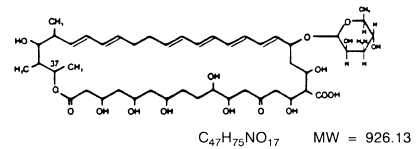Nystatin Oral Suspension
- Generic Name: nystatin (oral)
- Brand Name: Nystatin Oral Suspension
side effects drug center nystatin oral suspension (nystatin (oral)) drug
Drug Description
What is Nystatin Oral Suspension and how is it used?
Nystatin Oral Suspension is a prescription medicine used to treat the symptoms of fungal infections and candidiasis (yeast infections). Nystatin Oral Suspension may be used alone or with other medications.
Nystatin Oral Suspension belongs to a class of drugs called Antifungals, Other; Antifungals, Systemic.
What are the possible side effects of Nystatin Oral Suspension?
Nystatin Oral Suspension may cause serious side effects including:
- fast heart rate,
- trouble breathing,
- severe skin reaction,
- fever,
- sore throat,
- swelling in your face or tongue,
- burning in your eyes, and
- skin pain, followed by a red or purple skin rash that spreads (especially in the face or upper body) and causes blistering and peeling
Get medical help right away, if you have any of the symptoms listed above.
The most common side effects of Nystatin Oral Suspension include:
- mouth irritation,
- upset stomach,
- nausea,
- vomiting,
- diarrhea, and
- skin rash
Tell the doctor if you have any side effect that bothers you or that does not go away.
These are not all the possible side effects of Nystatin Oral Suspension. For more information, ask your doctor or pharmacist.
Call your doctor for medical advice about side effects. You may report side effects to FDA at 1-800-FDA-1088.
DESCRIPTION
Nystatin is an antimycotic polyene antibiotic obtained from Streptomyces noursei. Structural formula:
 |
Nystatin Oral Suspension is a cherry-mint flavored suspension for oral administration. It contains 100,000 USP Nystatin Units per mL. Inactive ingredients: alcohol ( ≤ 1% v/v), carboxymethylcellulose sodium, flavor, glycerin, methylparaben, propylparaben, purified water, saccharin sodium, sodium citrate, and sucrose (50% w/v). May also contain citric acid for pH adjustment.
Indications & Dosage
INDICATIONS
Nystatin Oral Suspension is indicated for the treatment of candidiasis in the oral cavity.
DOSAGE AND ADMINISTRATION
Infants: 2 mL (200,000 units) four times daily (in infants and young children, use dropper to place one-half of dose in each side of mouth and avoid feeding for 5 to 10 minutes). NOTE: Limited clinical studies in premature and low birth weight infants indicate that 1 mL four times daily is effective.
Children and Adults: 4–6 mL (400,000 to 600,000 units) four times daily (one-half of dose in each side of mouth). The preparation should be retained in the mouth as long as possible before swallowing.
Continue treatment for at least 48 hours after perioral symptoms have disappeared and cultures demonstrate eradication of Candida albicans.
HOW SUPPLIED
Nystatin Oral Suspension, USP, 100,000 USP Nystatin Units per mL, is available as a cherry-mint flavored, light creamy yellow, ready-to-use suspension in 60 mL bottles with calibrated dropper and 473 mL bottles.
Storage
Store at 20°-25°C (68°-77°F) with excursions permitted between 15°-30°C (59°-86°F) [See USP Controlled Room Temperature]; avoid freezing.
Manufactured for: Qualitest Pharmaceuticals, Huntsville, AL 35811. Revised: Apr 2015
Side Effects & Drug Interactions
SIDE EFFECTS
Nystatin is well tolerated even with prolonged therapy. Oral irritation and sensitization have been reported (See PRECAUTIONS: General).
Gastrointestinal
Diarrhea (including one case of bloody diarrhea), nausea, vomiting, gastrointestinal upset/disturbances.
Dermatologic
Rash, including urticaria has been reported rarely. Stevens-Johnson syndrome has been reported very rarely.
Other
Tachycardia, bronchospasm, facial swelling, and nonspecific myalgia have also been reported.
DRUG INTERACTIONS
No information provided.
Warnings & Precautions
WARNINGS
No information provided.
PRECAUTIONS
General
This medication is not to be used for the treatment of systemic mycoses.
Discontinue treatment if sensitization or irritation is reported during use.
Carcinogenesis, Mutagenesis, Impairment Of Fertility
No long-term animal studies have been performed to evaluate carcinogenic potential. There also have been no studies to determine mutagenicity or whether this medication affects fertility in males or females.
Pregnancy
Teratogenic Effects - Category C
Animal reproduction studies have not been conducted with nystatin oral suspension. It is also not known whether nystatin oral suspension can cause fetal harm when administered to a pregnant woman or can affect reproduction capacity. Nystatin oral suspension should be given to a pregnant woman only if clearly needed.
Nursing Mothers
It is not known whether nystatin is excreted in human milk. Because many drugs are excreted in human milk, caution should be exercised when nystatin is administered to a nursing woman.
Pediatric Use
See DOSAGE AND ADMINISTRATION.
Overdosage & Contraindications
OVERDOSE
Oral doses of nystatin in excess of five million units daily have caused nausea and gastrointestinal upset.
There have been no reports of serious toxic effects or superinfections (See CLINICAL PHARMACOLOGY: Pharmacokinetics ).
CONTRAINDICATIONS
The preparation is contraindicated in patients with a history of hypersensitivity to any of its components.
Clinical Pharmacology
Pharmacokinetics
Gastrointestinal absorption of nystatin is insignificant. Most orally administered nystatin is passed unchanged in the stool. In patients with renal insufficiency receiving oral therapy with conventional dosage forms, significant plasma concentrations of nystatin may occasionally occur.
Microbiology
Nystatin is both fungistatic and fungicidal in vitro against a wide variety of yeasts and yeast-like fungi. Candida albicans demonstrates no significant resistance to nystatin in vitro on repeated subculture in increasing levels of nystatin; other Candida species become quite resistant. Generally, resistance does not develop in vivo. Nystatin acts by binding to sterols in the cell membrane of susceptible Candida species with a resultant change in membrane permeability allowing leakage of intracellular components. Nystatin exhibits no appreciable activity against bacteria, protozoa, or viruses.
Medication Guide
PATIENT INFORMATION
No information provided. Please refer to the PRECAUTIONS section.




